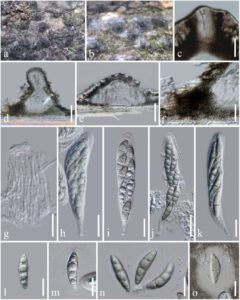Occultibambusa hongheensis H.B. Jiang, K.D. Hyde & Phookamsak, sp. nov.
Index Fungorum number: IF558429; Facesoffungi number: FoF 09884; Figure 1
Etymology: The specific epithet “hongheensis” refers to the location, Honghe, Yunnan Province of China, where the new species was collected.
Holotype: HMAS 249944
Saprobic on dead branches of bamboo. Sexual morph: Ascostromata 180–340 μm high, 400–550 μm diam., solitary or gregarious, immersed under host cortex, ampulliform, conical to subglobose, flattened at the base, uni- to bi-loculate, black, coriaceous, with 80–125 μm broad, central, periphysate ostiole. Peridium 40–130 μm thick, of unequal thickness, thin at the base, thick at sides, composed of several layers of pseudoparenchymatous cells of textura angularis, with palisade-like cells on the sides, outer layers consisting of dark brown pseudoparenchymatous cells, fused with host tissues, paler towards the inner layers. Hamathecium dense, composed of 1–2 μm wide, septate, branched, anastomosed, cellular pseudoparaphyses. Asci (78–)80–130(–137) × (18–)19–23(–25) μm (x̅ = 107.5 × 21.5 μm, n = 20), 8-spored, bitunicate, fissitunicate, cylindric-clavate to clavate, with a short pedicel, apically rounded with a distinct ocular chamber. Ascospores (25–)27–30 × (5.5–)8–9(–10) μm (x̅ = 28.8 × 8.4 μm, n = 20), partially overlapping 2-seriate, fusiform, 1-septate, slightly constricted at the septum, asymmetrical, upper cell broader and longer than the lower cell, straight to somewhat curved, hyaline when young and becoming pale brown when mature, smooth-walled, with guttules, surrounded by a broad mucilaginous sheath. Asexual morph: Undetermined.
Culture characteristics: Ascospores germinating on PDA within 24 hours and germ tubes produced from both cells of ascospores. Colonies were grown on PDA, reaching 30 mm after 4 weeks at room temperature (10–20 °C), under normal light conditions, colonies on PDA cottony, circular, raised, dense, pale grey to dark grey from above and below. Mycelium superficial to immersed in media, with branched, septate, smooth hyphae.
Material examined: China, Yunnan Province, Honghe Autonomous Prefecture, Honghe County, on the roadside (23°16’32.26″N, 102°25’30.37″E, altitude 1544.29 m), on dead branches of bamboo in a terrestrial environment, 28 October 2020, H.B. Jiang, HONGHE012 (HMAS 249944, holotype), ex-type living culture, KUMCC 21-0020.
Notes: An ITS nucleotide blast search found the new isolate to be closely related to Versicolorisporium triseptatum HHUF 28815 (89.19% similarity), Neooccultibambusa thailandensis MFLUCC 16-0274 (88.27% similarity), and Massarina sp. MUT 4860 (87.65% similarity), while LSU and TEF1-α nucleotide blast searches indicated that this new isolate belongs to Occultibambusa. Occultibambusa hongheensis is most similar to O. maolanensis, but differs in having pale brown ascospores with a broad mucilaginous sheath, longer asci (78–137 μm vs. 66–94 μm) [10], and smaller ascostromata (400–550 μm diam. vs. 544–600 µm diam) [10]. Based on multi-locus phylogenetic analyses, O. hongheensis is sister to O. maolanensis with high statistical support (100% ML, 1.00 PP; Figure 1). There are 14 base pair (1.54%; not including gaps) differences between O. hongheensis and O. maolanensis in comparing a total 910 of nucleotides across the TEF1-α region.

Figure 1. Occultibambusa hongheensis (KUN-HKAS, holotype). (a,b) Appearance of ascostromata on the host; (c) Periphysate ostiole; (d,e) Vertical sections of ascostroma; (f) Peridium arranged in textura angularis, with palisade–like cells the side; (g) Pseudoparaphyses; (h–k) Asci; (l–o) Ascospores [(o) Ascospore with mucilaginous sheath stained by Indian ink]. Scale bars: (d,e) = 100 μm; (c,f) = 50 μm; (j) = 30 μm; (g–i,k) = 20 μm; (l–o) = 15 μm.
